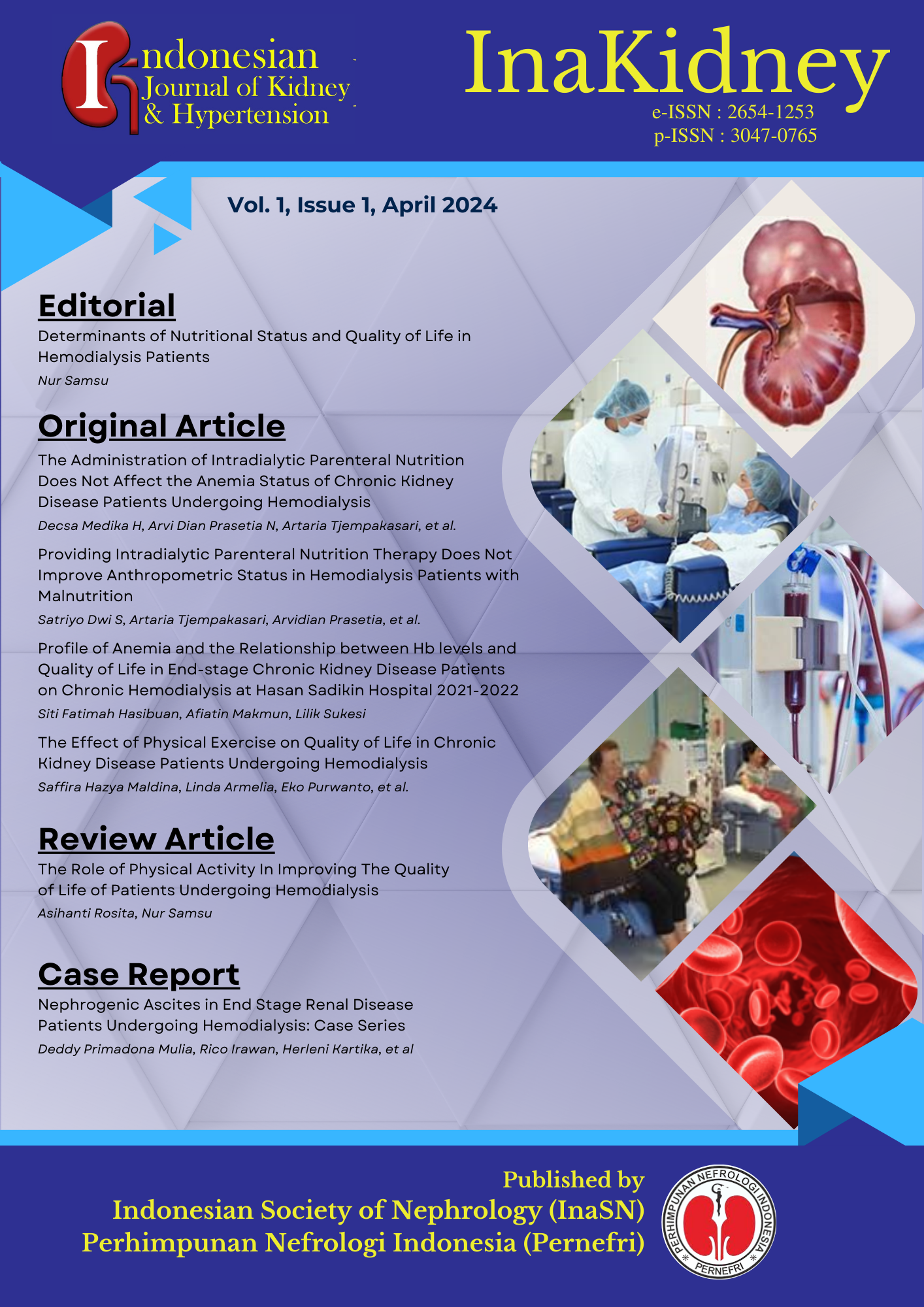The Administration of Intradialytic Parenteral Nutrition Does Not Affect the Anemia Status of Chronic Kidney Disease Patients Undergoing Hemodialysis
Abstract
Background: Hemodialysis (HD) patients are susceptible to malnutrition, and there is a close relationship between malnutrition and the incidence of anemia. Parenteral nutrition plays a role in treating malnutrition.
Objective: This study aims to determine the effect of parenteral nutrition on anemia in HD patients.
Methods: Quasi-experimental research which is part of the nutritional research tree at the Hemodialysis Unit of RSUP Dr. Soetomo Surabaya for 3 months. A total of 45 malnourished CKD patients (SGA B & C) undergoing routine HD were included in this study (n=26 received regular diet & education, n=17 received regular diet, education and intradialytic parenteral nutrition, and n=2 dropped out of school due to blood transfusion). Measurements of body mass index (BMI), hemoglobin (Hb), serum iron (SI), and total iron binding capacity (TIBC) were carried out before and 8 weeks after therapy. Between groups used the Mann-Whitney test, while pre and post used the Wilcoxon matched-pairs sign rank test.
Results: The treatment group was older than the control group. There was no difference in duration of HD between groups. Intradialytic parenteral nutrition had no effect on BMI (24.71±3.939 vs 24.71±4.026; p=0.3802), Hb (9.746±1.309 vs 9.162±1.960; p= 0.3525), SI (62.33±34.74 vs. 53.78±24.89; p=0.3594), and TIBC (242.8±119.0 vs. 197.3±43, 65; p=0.4258).
Conclusion: In HD patients, intradialytic parenteral nutrition for 8 weeks did not affect Hb, SI and TIBC levels. Long-term observations with larger samples are needed to confirm these findings.
Downloads
References
Portolés J, Martín L, Broseta JJ, Cases A. Anemia in Chronic Kidney Disease: From Pathophysiology and Current Treatments, to Future Agents. Front Med (Lausanne). 2021;8:642296.
Sahathevan S, Khor BH, Ng HM, Gafor AHA, Mat Daud ZA, Mafra D, et al. Understanding Development of Malnutrition in Hemodialysis Patients: A Narrative Review. Nutrients. 2020 Oct 15;12(10):3147.
Cano NJM, Aparicio M, Brunori G, Carrero JJ, Cianciaruso B, Fiaccadori E, et al. ESPEN Guidelines on Parenteral Nutrition: adult renal failure. Clin Nutr. 2009 Aug;28(4):401–14.
Radić J, Bašić-Jukić N, Vujičić B, Klarić D, Radulović G, Jakić M, et al. Anemia Is Correlated with Malnutrition and Inflammation in Croatian Peritoneal Dialysis Patients: A Multicenter Nationwide Study. Perit Dial Int. 2017;37(4):472–5.
Zha Y, Qian Q. Protein Nutrition and Malnutrition in CKD and ESRD. Nutrients. 2017 Feb 27;9(3):208.
Cano NJM, Fouque D, Roth H, Aparicio M, Azar R, Canaud B, et al. Intradialytic parenteral nutrition does not improve survival in malnourished hemodialysis patients: a 2-year multicenter, prospective, randomized study. J Am Soc Nephrol. 2007 Sep;18(9):2583–91.
Kittiskulnam P, Banjongjit A, Metta K, Tiranathanagul K, Avihingsanon Y, Praditpornsilpa K, et al. The beneficial effects of intradialytic parenteral nutrition in hemodialysis patients with protein energy wasting: a prospective randomized controlled trial. Sci Rep. 2022 Mar 16;12(1):4529.
Czekalski S, Hozejowski R, Malnutrition Working Group. Intradialytic amino acids supplementation in hemodialysis patients with malnutrition: results of a multicenter cohort study. J Ren Nutr. 2004 Apr;14(2):82–8.
Lu JL, Kalantar-Zadeh K, Ma JZ, Quarles LD, Kovesdy CP. Association of body mass index with outcomes in patients with CKD. J Am Soc Nephrol. 2014 Sep;25(9):2088–96.
Marsen TA, Beer J, Mann H, German IDPN-Trial group. Intradialytic parenteral nutrition in maintenance hemodialysis patients suffering from protein-energy wasting. Results of a multicenter, open, prospective, randomized trial. Clin Nutr. 2017 Feb;36(1):107–17.
Copyright (c) 2024 Indonesian Journal of Kidney and Hypertension

This work is licensed under a Creative Commons Attribution 4.0 International License.
Authors who publish with Indonesian Journal of Kidney and Hypertension agree to the following terms:
- Authors retain copyright and grant Indonesian Journal of Kidney and Hypertension right of first publication with the work simultaneously licensed under a Creative Commons Attribution-NonCommercial License that allows others to remix, adapt, build upon the work non-commercially with an acknowledgment of the work’s authorship and initial publication in Indonesian Journal of Kidney and Hypertension.
- Authors are permitted to copy and redistribute the journal's published version of the work non-commercially (e.g., post it to an institutional repository or publish it in a book), with an acknowledgment of its initial publication in Indonesian Journal of Kidney and Hypertension.






1.png)



